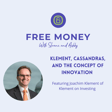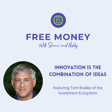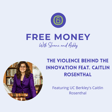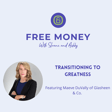
How Resilience Drives Investment Returns Featuring LTSE’s Jean Rogers
Good things are happening even as we endure a global crisis.
A Mumbai-based startup has successfully reversed the aging process in rats, a previously unthinkable breakthrough.
A new era in American spaceflight begins tomorrow, when two astronauts travel to the International Space Station onboard a SpaceX Falcon 9 Rocket. It will be the first crewed launch from the US since the shuttle program ended in 2011 and the first time a new type of spacefaring vehicle has carried humans from Cape Canaveral to the heavens since 1981.
And Blackrock — the world’s most humongous asset manager — reported that the recent downturn in financial markets had only strengthened their conviction in sustainable investing strategies. At this and other firms, Environmental, Social, and Governance (ESG) driven investment strategies are increasingly understood as a source of comparative resilience in portfolios, not just ethically admirable allocations that are “nice to have.”
This is clearly rad.
But it also pushes one to wonder about the harbingers of resilience. We wanted to do better than hoping we’d know it when we saw it. So we called Jean Rogers, Chief Resilience officer at the Long-Term Stock Exchange (LTSE) and a founding mother of the global sustainable investing movement.
As founder and CEO of the Sustainable Accounting Standards Board (SASB), she created industry-specific materiality frameworks that opened the investment profession’s eyes to the promise of ESG investing. And she’s hard at work to compound that contribution.
In our conversation, she pushed us to see the set of things that matter to a company’s performance as more than just a static list. Conditions change. And circumstances can arise where something “wasn't material for a company one day and now stakeholders are up in arms about it. Now it's a material condition for the company.”
She recently outlined a framework for this process of transformation in a paper co-authored with Harvard Business School’s George Serafeim which urged investors to understand materiality as a “process of becoming” rather than a “state of being.”
In our conversation, she outlined five factors analysts can use to assess a company’s capacity for resilience to acute events or exogenous shocks. The first, is "bigness of vision," or:
The transformative impact of their vision. “Bigness of vision matters because it creates momentum. People — other stakeholders, policy makers, employees, and investors — rally around the company because they want the company to succeed in achieving that big vision. So think of Tesla and its vision not only of producing amazing cars, but transitioning to a renewable infrastructure. That bigness of vision really can carry a company through volatile events and tough times.”On inventiveness:
“That's prolific innovation where you don't have to really worry about your intellectual property much because you're actually confident you're going to produce more. So you don't have to protect it, you can open source it and enable human progress, enable others to build on what you're doing. And you're going to continue to execute because you're investing in innovation and you’ve created a culture of experimentation. Think of Google, which puts a great deal of of its capital expenditures into innovation and long-term strategy. Think of Amazon, which invests more in R&D than marketing.”








